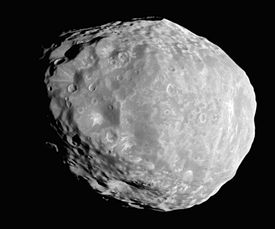Janus (moon)

Janus as imaged by Cassini on 2010-04-07: highest-resolution full-disk image to date
|
|
| Discovery | |
|---|---|
| Discovered by | Audouin Dollfus |
| Discovery date | 15 December 1966 |
| Designations | |
| Pronunciation | /ˈdʒeɪnəs/ JAY-nəs |
|
Named after
|
Janus |
| Adjectives | Janian |
| Orbital characteristics | |
| Epoch December 31, 2003 (JD 2 453 005.5) | |
| 151460±10 km | |
| Eccentricity | 0.0068 |
| 0.694660342 d | |
| Inclination | 0.163°±0.004° to Saturn's equator |
| Satellite of | Saturn |
| Physical characteristics | |
| Dimensions | 203 × 185 × 152.6 km |
|
Mean radius
|
89.5±1.4 km |
| Volume | ≈ 716000 km3 |
| Mass | (1.8975±0.0006)×1018 kg |
|
Mean density
|
0.63±0.03 g/cm³ |
| 0.011–0.017 m/s2 | |
| synchronous | |
| zero | |
| Albedo | 0.71±0.02 (geometric) |
Janus is an inner satellite of Saturn. It is also known as Saturn X. It is named after the mythological Janus.
Janus was identified by Audouin Dollfus on 15 December 1966 and given the temporary designation S/1966 S 2. Previously, Jean Texereau had photographed Janus on 29 October 1966 without realising it. On December 18, Richard Walker observed an object in the same orbit as Janus, but whose position could not be reconciled with the previous observations. Twelve years later, in October 1978, Stephen M. Larson and John W. Fountain realised that the 1966 observations were best explained by two distinct objects (Janus and Epimetheus) sharing very similar orbits, Rick Walker is now credited with the discovery of Epimetheus.Voyager 1 confirmed this orbital configuration in 1980. (See co-orbital moon for a more detailed description of their unique arrangement.)
Janus was observed on subsequent occasions and given different provisional designations. Pioneer 11's three energetic-particle detectors detected its "shadow" when the probe flew by Saturn on 1 September 1979 (S/1979 S 2.) Janus was observed by Dan Pascu on 19 February 1980 (S/1980 S 1,) and then by John W. Fountain, Stephen M. Larson, Harold J. Reitsema and Bradford A. Smith on 23 February 1980 (S/1980 S 2.)
Janus is named after the two-faced Roman god Janus. Although the name was informally proposed soon after the initial 1966 discovery, it was not officially named until 1983, when Epimetheus was also named.
The Oxford English Dictionary lists the adjectival form of the moon's name as Janian.
...
Wikipedia
